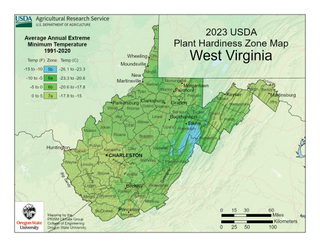West Virginia Planting Zones - USDA Map Of West Virginia Growing Zones

Click on the image above to see a larger version.
About the West Virginia Planting Map
The West Virginia USDA plant hardiness map, as featured above, is based on new data collected by the USDA over a thirty-year period. Weather stations throughout the country gathered essential data for the map, which was released at the end of 2023.
The new 2023 map made some zone adjustments for the winter warming trend and took into consideration an area's proximity to a large body of water, elevation, and the urban heat factor. West Virginia zones include 5b at the highest elevation in the east to 7a near the southern part of the state. The majority of the state falls in zones 6a and 6b with extreme average winter low temperatures down to -10 degrees F. (-12 C.). New and experienced gardeners benefit greatly from the zone information provided by the map.
To find your zone, you can enlarge the map above by clicking on it or visit the USDA site and input your zip code to find your zone. When you use the plant hardiness information as a guide for selecting plants, you will find that the majority, if not all, plant distributors provide this information on their plant tags. Although the map is not a 100% guarantee that a plant will survive, it is a good place to start. Be sure to follow planting and care directions carefully, and remember, you can always bring plants indoors for the winter if they are not suited for your area.
Gardening tips, videos, info and more delivered right to your inbox!
Sign up for the Gardening Know How newsletter today and receive a free download of our most popular eBook "How to Grow Delicious Tomatoes."
-
 Urban Composting Guide: How To Compost In The Middle Of The City
Urban Composting Guide: How To Compost In The Middle Of The CityUrban composting does not have to be daunting. You can compost in the city, and maybe even try some urban worm composting!
By Mary Ellen Ellis
-
 Shrub Diseases And Pests To Watch Out For
Shrub Diseases And Pests To Watch Out ForShrub diseases and pests can be challenging. Learn how to recognize and eradicate them before they can present a danger to your plants.
By Susan Albert